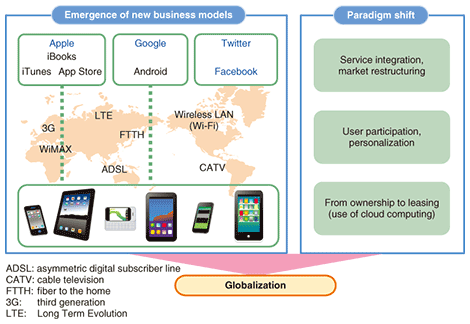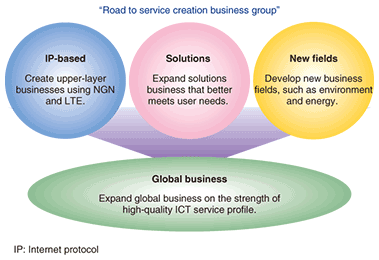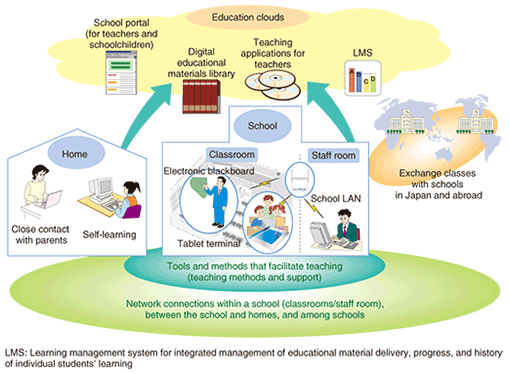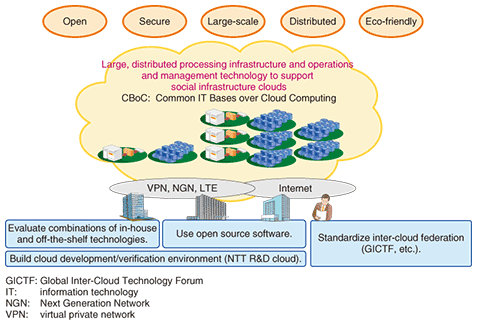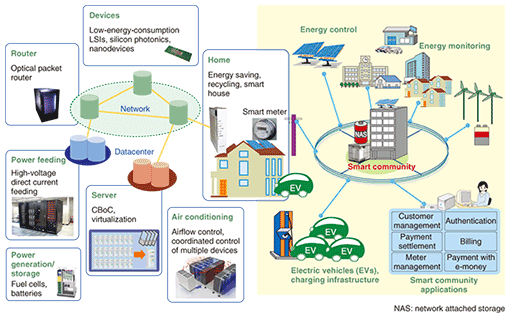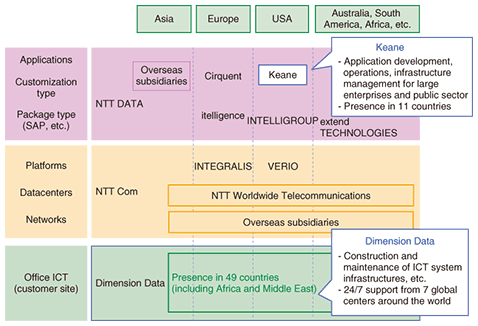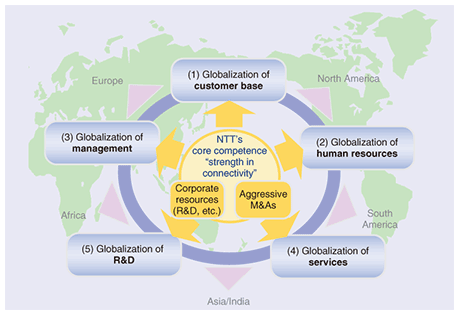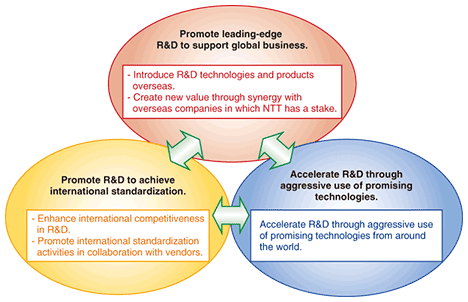 |
|||||
|
|
|||||
|
Feature Articles: Keynote Speeches at NTT R&D Forum 2011 Vol. 9, No. 4, pp. 1–11, Apr. 2011. https://doi.org/10.53829/ntr201104fa1 NTT Group’s Business Strategy in the Fast-Changing Global MarketAbstractThis article introduces NTT’s research and development (R&D) activities aimed at supporting widespread use of information and communications technology and its activities in pursuit of global business expansion. It is based on the keynote address given in Japanese by Satoshi Miura, President and Chief Executive Officer of NTT, at the NTT R&D Forum 2011, held on February 21–23, 2011. 1. ICT: driving the economyAlthough Japan still faces severe economic conditions such as appreciation of the yen and deflation, the third-quarter financial results for a number of businesses appear to signal some degree of recovery. The forces driving this development are said to be the penetration of smartphones and the growth of emerging countries. In particular, expanded use of smartphones is surpassing all forecasts. For example, NTT DOCOMO initially set a goal of selling 300,000 smartphones in fiscal year 2010, but made an upward adjustment to 2.5 million units in its third-quarter financial accounts. Moreover, the company expects to sell 6 million smartphones in fiscal 2011. Thus, smartphones are selling at an extremely fast rate. According to a research firm in the USA, worldwide shipments of smartphones exceeded those of personal computers during the period October through December 2010. Therefore, we can say that information and communications technology (ICT) is driving the economy. 2. Dramatic changes in ICT2.1 Service integration and market restructuringService integration is taking place in all fields. Widespread use of smartphones, tablet terminals, and wireless local area networks (LANs) enables people to access a variety of services from anywhere. Convergence of fixed and mobile services is gathering momentum. New vertical integration-based business models, in which a single provider offers both terminals and content applications as a package, are emerging in rapid succession, spearheaded by offerings from Google and Apple. 2.2 User participation and personalizationUser-participation-type, or interactive-type, social media have begun to exert a powerful influence. In particular, the number of Facebook users has been growing so fast that it has already reached 600 million worldwide. Facebook is said to have played an important role in igniting the movements toward democracy in nations in the Middle East and North Africa, touched off by events in Tunisia and Egypt. Such social media have become powerful enough to help bring down a government. Furthermore, personalized services, such as “i-concier” [1] (from i-concierge) provided by NTT DOCOMO, are also spreading. 2.3 From ownership to leasing (use of cloud computing)Use of cloud computing is growing globally. Today, people frequently access clouds without realizing that they are doing so. The shift from ownership of systems to lease arrangements is accelerating. As shown in Fig. 1, the paradigm shifts mentioned above are spreading rapidly on a global scale.
3. Road to service creation business groupUnder these circumstances, we have sought to reinforce our network infrastructure and have met our progress goals, i.e., to achieve high penetration of optical services and expand the area in which the Next Generation Network (NGN) service is available. In the arena of mobile services, most phones now in use are 3G (third-generation) phones. We launched a Long Term Evolution (LTE) service, which we call “Xi”, in December 2010. The NTT Group’s next target is to provide a variety of services in our world-leading broadband environment. For this purpose, we have adopted a growth strategy comprising four key elements, as shown in Fig. 2. Research and development (R&D) activities being directed on the basis of this strategy are described below.
4. Innovation through R&D4.1 R&D areasNTT is undertaking a broad spectrum of R&D activities in the following four areas: (Fig. 3). (1) Core communications technologies: optical transmission, monitoring and analysis of large networks, virtualization, etc. (2) New service-related technologies: cloud infrastructure, three-dimensional video encoding, Home ICT [2], security, etc. (3) Innovative technologies: electronic/optical materials, cryptography, etc. (4) Enhancement of the environment and service quality: environment, energy, etc.
In line with NTT’s aims of contributing to the resolution of social issues and improvement of people’s lives through ICT innovation, NTT’s R&D seeks to play a leading role in the NTT Group’s efforts toward becoming a service creation group by exploiting its R&D results. 4.2 Significance of R&DJapan’s world-class broadband environment is the outcome of a wide range of R&D activities, including years of research on optical transmission, for example, the development of technologies to reduce the costs of broadband networks and simplify the work involved in installing optical fibers. The inroads made by Internet protocol (IP) technology have prompted us to increasingly adopt commercially available products, which is a departure from the traditional emphasis on in-house-development, and have also shifted the primary R&D focus away from hardware toward software. There are two good reasons why NTT, as a carrier, should engage in R&D. The first is the need to develop innovations that will enable networks as a whole, including the network operations aspect, to satisfy the requirements of serviceability and economy on the one hand and to achieve carrier-grade quality and reliability on the other hand. The second reason is an increased need for innovations that will enable a variety of services to be created in order to enhance user convenience and innovations that will make possible sophisticated linkages between these services and the networks. 4.3 Importance of expanding ICT utilizationThe term broadband network embraces not only optical networks but also cable television (CATV), asymmetric digital subscriber line (ADSL), and wireless networks. In other countries, mobile networks are frequently the dominant broadband networks. A case in point is the U.S. market, where it has been promised that a next-generation wireless broadband network will become available to 98% of the population within the next five years. Japan’s broadband environment leads the world. The Ministry of Internal Affairs and Communications reports that broadband access covers 99.1% of households in Japan and that super-high-speed broadband access at 30 Mbit/s or more covers 91.6% (as of the end of March 2010) (Fig. 4).
However, Japan lags behind in ICT utilization in public service areas such as public administration, medical care, and education. There is an urgent need to strengthen efforts to correct this situation. Widespread use of broadband services prompts the construction of broadband infrastructures. The promotion of use and construction are as inseparable as the two wheels of a cart. 4.4 Vigorous society and richer futureSpecific examples of ICT utilization are described below. 1) Enhancement and visualization of public administration services Most administrative agencies currently require mainly paper-based applications for services. Sharing of information within administrative offices is limited owing to the vertically segmented administrative setup. Full use of ICT could dramatically enhance both convenience for citizens and efficiency in administrative processes by, for example, providing a one-stop service from the user perspective, providing push-type services, and enabling citizens to control their personal information. 2) Linkage between healthcare and medical data The use of clouds can enhance the quality of regional medical care because they enable patients’ medical records and other data to be shared both within and among hospitals with high security. The NTT Group has conducted field trials on remote health consultation in the cities of Tono and Kurihara and on electronic medical records and remote support of regional medical care with NTT Medical Center in Tokyo. Our goal is to enable everyone in Japan to receive high-quality medical care wherever they are, as envisioned in the government’s “My Hospital Anywhere” initiative. 3) Education Square × ICT In a bid to create an educational environment in which teachers find it easy to teach and schoolchildren can take more interest in deepening their learning, we have launched the “Education Square × ICT” project (Fig. 5). In fiscal 2011, we will start field trials of this project in eight elementary schools in four municipalities. These will be followed later by the addition of junior high schools. These trials will not only link classrooms within individual schools but also link the schools to the children’s homes and interconnect schools to support all aspects of the envisioned new approach to education.
To promote widespread use of ICT in public sectors, it is important to ensure reliability and security. In pursuit of safe and secure clouds, the NTT Group is undertaking R&D of the construction of an infrastructure that links social information owned by different organizations. The infrastructure will interwork with sophisticated network functions to provide a wide range of security functions (Fig. 6).
4) R&D aimed at reducing environmental impacts The exponential growth in ICT traffic requires an increasing amount of telecommunications equipment, which, in turn, rapidly increases power consumption. R&D for reducing environmental impacts is gaining in importance (Fig. 7). We are seeking to reduce CO2 emissions by both the NTT Group (a program we call Green of ICT) and by society in general (Green by ICT).
The NTT Group’s environment vision, called “THE GREEN VISION 2020”, sets a target of a 15% reduction in CO2 emissions by fiscal 2020 compared with the volume in fiscal 2008. We are intensifying our environmental efforts to achieve this goal. 5. Expansion of global businessAmong our global business activities, mobile communications business that targets consumers and systems integration and network integration business that targets corporate customers are described below. 5.1 Mobile businessThe number of mobile phone subscribers worldwide exceeded 5 billion by the end of 2010, far surpassing the number of fixed-line phone subscribers (1.2 billion). A rapid increase in mobile phone numbers is particularly evident in emerging Asian and African countries, which are registering dramatic economic growth. Services that are possible only through the use of mobile phones are gaining in popularity. NTT DOCOMO is conducting the following activities aimed at capturing a significant share of this rapidly growing mobile market (Fig. 8).
1) Provision of network services in quickly growing countries In quickly growing countries, particularly those in Asia, NTT DOCOMO is expanding its network base through investment in or partnership with local carriers that already have significant customer bases. Although most revenue is derived from voice calls, the company is seeking to capture the data communications market, which will be boosted by the economic growth of these countries. 2) Provision of value-added services In countries where network infrastructures are well-developed, NTT DOCOMO will expand and strengthen its value-added services. For example, using the “net mobile AG” platform that it has acquired in Germany, NTT DOCOMO is collecting content, such as i-channel and manga, from around the world and delivering it to the world from its German platform. To expand its business overseas, the company will provide cloud-based services with a focus on platform services that can deliver a variety of content regardless of where in the world the content is produced or consumed. 5.2 Businesses for corporate customersAnticipating rising demand in high-potential markets in emerging countries, enterprises are jumping on the bandwagon and accelerating expansion of their global businesses by entering these markets. Against this background, there is a growing need for ICT to provide solutions for business processes that have become too complex and tangled. Enterprises are also increasingly outsourcing the management of their ICT bases, which are becoming more and more sophisticated and complex. In other words, there is a steady shift toward the use of clouds. With a view to supporting geographical business expansion by global enterprises, we have adopted service profile reinforcement and geographical service coverage expansion as the main thrusts of our global business strategy and have been actively pursuing mergers and acquisitions (M&As) (Fig. 9). Global expansion by enterprises has proceeded faster than we anticipated, and it has become impossible to satisfy the increasingly diverse needs of our customers through only our own resources. We have moved swiftly to plug this gap through M&As; for example, Cirquent and itelligence, which have extensive skills in specialized applications such as SAP applications, and Keane, which was acquired last year. We also purchased Dimension Data because it has become important to rapidly support customers’ business, including LAN installation, operation, and maintenance in customers’ offices, and because we need to supplement our services in emerging countries where our current service coverage is inadequate.
These business expansions and M&As have begun to yield positive results; for example, we received consecutive orders from an energy-related company that has a presence in 30 countries and from a U.S. pharmaceutical company that has business sites in 15 Asian countries. 5.3 Future expansion of global businessThanks to the provision of comprehensive ICT solutions and global expansion of services, the Group is expected to record sales of US$4 billion from overseas business in fiscal 2010, which is double the US$2 billion recorded in fiscal 2007. We are aiming at sales (simple addition) of about US$8 billion by fiscal 2011, and US$10 billion by fiscal 2012. Following the above acquisitions, the number of overseas employees has increased to about 40,000, while the number of global enterprise customers is heading for about 10,000. These figures will rise as we continue to expand our global business. 5.4 Aiming to become a true global playerOn the strength of various management resources and the business resources acquired through M&As, we have capitalized on our comprehensive strength in connectivity spanning all layers from applications and platforms to networks. As a result, we have continued to record steady growth in global business. However, the important challenges involved in becoming a true global enterprise acting as a main player in the coming era of clouds are still ahead. To meet those challenges, we need to pursue the following activities (Fig. 10): (1) Globalization of the customer base. We will promote cross-selling on a customer base that has expanded by about 10,000 enterprises as a result of the M&As of overseas companies and will also take advantage of synergy with these companies to capture global enterprises and large enterprises as new customers. (2) Globalization of human resources. We will encourage globalization of human resources by increasing the employment of foreign students studying in Japan and of overseas local residents, bringing local employees to Japan, dispatching Japanese employees overseas, and conducting personnel exchanges among the acquired overseas companies. (3) Globalization of management. While we respect the autonomy of management in individual companies, we will retain central governance in matters related to the NTT Group’s global business strategies and management. (4) Globalization of services. Globalization by our customers has given rise to increased diversity in service demands. We will build a varied and flexible service profile to satisfy those user needs. (5) Globalization of R&D: We will increasingly globalize our R&D, which is one of our core competences.
5.5 R&D for global business expansionActivities to globalize R&D, which is essential to our business expansion, are described below (Fig. 11): 1) Promotion of leading-edge R&D to support global business This is an activity aimed at commercializing R&D results in the global market. We have a good track record in many product areas. Our free-bending optical fiber cords, small-diameter low-friction indoor optical fiber cables, and optical connecters have gained large shares of the respective world markets. Our video encoders were used at the Olympic Games and the World Cup by broadcasters from a number of countries. In developing cutting-edge technologies related to ubiquitous broadband networks and services, and products related to clouds and security, we urgently need to pay even greater attention to the global market and intensify global business, including stronger collaboration with acquired overseas companies. 2) Promotion of R&D to achieve international standardization or establish de facto standards In addition to ongoing conventional standardization activities that have achieved good results in optical technologies, such as the passive optical network (PON) for fiber to the home (FTTH), technical specifications for video coding and Internet protocol television (IPTV), and encryption methods, we need to boost our efforts to establish de facto standards that are directly linked to our global business and are likely to increase our revenue. 3) Acceleration of R&D through aggressive use of promising technologies from outside the Group As business models continue to change rapidly, driven mainly by standardized IP technology, it is necessary to collect relevant information by paying even more attention to developments taking place around the world and to adopt relevant technologies and products, or incorporate them into existing ones, in order to accelerate R&D.
6. Efforts to boost R&DThe world is undergoing a rapid paradigm shift of global magnitude. This has led many enterprises to strive harder to make their R&D activities more competitive. NTT R&D is no exception. 6.1 Swift and flexible R&D to respond to changes in the Group’s businessOur business structure is changing rapidly. It has become more important than ever for R&D to adapt swiftly and flexibly in response to changes in the Group’s business. For example, it is essential to target those businesses that have high growth potential. As mobile business gains weight within the Group, we must strengthen collaboration between NTT’s laboratories and those of NTT DOCOMO and steer R&D through a more comprehensive approach combining fixed and mobile technologies. Since business focus is shifting from network-centric services to upper-layer services, it is also necessary to review the relative weights and balances among different R&D areas. 6.2 Reduced time from R&D to market and closer collaboration with operating companiesIt is important to work closely and in a timely manner with operating companies. We have introduced commercialization assistance functions to overcome the valley of death that lies between R&D and commercialization. With respect to human resources, we have not only promoted personnel exchanges between our laboratories and operating companies but also introduced what we call direct current, whereby researchers are transferred to operating companies along with the products they have developed so that they can be directly involved in the commercial introduction of those products. It is necessary to reduce the time from R&D to market by accelerating these activities, paying more attention to business needs, and collaborating with operating companies at even earlier stages of R&D. 6.3 Stronger competitiveness through R&D diversityAt the same time, it is also essential to strengthen competitiveness by ensuring diversity in R&D. In an effort to encourage innovative, leading-edge research, we have introduced a system of Fellows, a Senior Distinguished Researcher, and two Senior Distinguished Scientists. In addition, we need to hire more foreign researchers and intensify R&D collaboration with universities and enterprises both at home and abroad. Innovation is often created through an encounter with a dissimilar research area. Ensuring diversity in R&D will enable us to respond flexibly to the needs of the times, which continue to grow in diversity and complexity, thereby strengthening our competitiveness. 7. NTT Group’s future activitiesAs a core competence of the NTT Group, R&D must contribute to the Group’s business by forging paths into both the domestic and global markets and by translating its results into profitable businesses and services. We at the NTT Group will strive to assist in the economic development and resolution of social issues by further developing safe, secure, and open ubiquitous broadband networks and by creating more convenient services in collaboration with a variety of players. Through these activities, we seek to contribute to the creation of a vigorous society and a richer future. References
|
|||||








